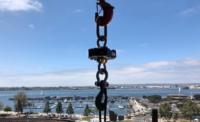ENR sat down with Martin Fischer, the director of Stanford University’s Center for Integrated Facilities Engineering, for a wrap-up interview at the conclusion of CIFE’s 2016 “summer session,” Sept. 22. The annual sessions give CIFE’s researchers and industry partners a review of research under way and gains made for increasing construction productivity through the use of virtual design and construction.
ENR: What is your take away from this year’s CIFE Summer Session?
Fischer: “What I saw is real confidence that we can really get rid of a whole bunch of waste from conflicts and requests for information, changes and punchlists. We don’t have to plan for it, include it in the budget, or allow time for it.
“We saw performances that just eradicated a whole bunch of work that people spend a significant amount of time on, [like] dealing with change orders and RFIs, punch lists, clashes and things like that. We saw approaches and documented successes that get rid of this kind of waste. And I saw, for the first time, people imagining—now that we are confident that we can do that— what we could achieve in terms of success for the project, the client and success for suppliers of design and construction.”
Fischer:“The mechanism for today’s success is a combination of three things, two traditional ones and one that’s new. The traditional ones are to gather the right people and engage them in the right process and build trust. What we are adding now is the effective use of technology, which is what’s really new. People say its not really about technology, but I keep coming back to it because, without the technology, without the BIM, without the data, without the visualization, we couldn’t give the people that are coming together the basis to really trust each other and move forward with confidence. Without the technology you wouldn’t have that level of understanding and you couldn’t have that level of trust. We have seen several examples now of where people have put those three things together.”
ENR: Why was CIFE started and how long have your been here?
Fischer: “CIFE was started because my colleagues, current and retired, saw the emergence of the technology now known as BIM out of computer science in the 1980s, and they realized that this could change the game, because it would allow us to build and operate virtually, to simulate and understand how building a road—or any facility—could be performed and how would we get there—all in the computer.
“Then they realized that wouldn’t work, because there is no one person who has all of that knowledge, so we would have to change organizations and processes to bring these people together. That was vision that they had in 1986 when they first wrote a proposal to the National Science Foundation for an engineering research center—which was rejected.
“Then, basically throughout 1987 they continued to work on it. They saw this was a good idea, this was a good vision, this will happen, and this is the leadership you have to have. This is what we need to do because it will require a whole host of new knowledge of how building works that we currently don’t even realize is needed. We need to create new simulations, we need to create new management knowledge and new management approaches and things like that. These are the things we started, and really in the last few we years, this is what we’ve seen happening.
“I was in the first group of students funded by the CIFE community, and my vision—and in some ways I still work on it— was that I said, ‘OK, I’ve seen 3D models, but really, the power will be when we connect them with information. So, together with Kenji Itoh from Shimizu —he was a so-called visiting fellow at CIFE, which is a visiting researcher sent by a company—and me. We were supported by Mike Kolountzakis, a MS student in Math, who did the Autolisp programming in Autodesk version 9 to allow us to represent building components and information about them—size, location, material, connections—as what is now known as Building Information Model elements.
“I think we built the first BIM tool. You don’t really realize it at the time and its tough to know because BIM is really big. There had been 3D used and visualization, but I hadn’t run across anybody who had a tool where you would model a building and then you could analyze it. The analysis I did was on constructability. Basically I collected constructability knowledge, which other people also had done, but those lessons never went anywhere, and I realized it has to be coming into design. You have to bring design and construction together.
“I am just talking about my project because I know it; there were others… we were really kind of exploring, but not imaging that it would take this long for this to take hold.
“The surprising thing is, what we had here this week was a two-day conference. What we had in 1991 was a two-week conference. Forty people would show up for two weeks to talk about model-based design and construction—and we had precious little to show! I’ve got to dig up the agendas from those sessions and look at what the heck did we do!
“It’s such a shift in the industry. I reflect back at what the people came for, and they left with sort of a vision and an idea, but there was nothing concrete we could give them in terms of, here is something you can actually go do. There was nothing like that.
“The 90s were really a lot about possibilities. We explored a lot of technologies. And then the 2000s to 2010 we started to “concretize” things. I see for us now a bit of a challenge because, if I compare what we saw last year to what we see this year, the rate of adoption in the leading companies is accelerating quite rapidly.”
ENR: One of the hallmarks of great technology is that you don’t know it’s there, and what I am seeing here at CIFE is a lot of focus on organization, and collaboration and timing, and not so much on technology tools. Is that because the tools have matured?
Fischer: “We still do some research on tools because we see some next generation opportunities, but when we work with companies now there is a lot more focus on exactly those aspects. People are now taking certain performance for granted because the tools have kind of disappeared and this is just how we work.”
ENR: Take us forward. What do you see happening next for CIFE, and what’s the five year track?
Fischer: “I think in five years we will understand a couple of things better—if I am a little bit optimistic. We will understand the value of a building or a piece of infrastructure better in terms of the value to the society, the community, but also its immediate users. And we will understand the connection between buildings and infrastructure better, and be able to see the bigger picture and understand the context in a better way. We’ll use the cloud parallelization and optimization methods to explore design options and we will have closed feedback loops on many levels—from the room level, to the building level, to the system level.
“And what I hope will happen, is that the owners will really behave very differently. They focus too much on the nitty-gritty today and they should really focus on how their buildings are performing and how does that performance affect their ability to do their business and where they need to improve.
“[If they do] they could actually challenge the designers and constructors to deliver that performance—and then leave it to design and construction to do it.
“That’s where I got so hopeful after this conference—I started to see them, in a few cases, getting out of the mundane wasteful details of nitty-gritty coordination and fixing things so they could have time to answer these more important performance questions for the owner.
“The job of designers and constructors will have to be that some of them work at a much higher level than they work today and let the computers do the design and analysis. And others will need to work at the level of the tools. You’ve got to have the tools; they will be really important. You cannot do it without the tools.
“That’s quite a dramatic shift....maybe five years is ambitious for us.”




Post a comment to this article
Report Abusive Comment